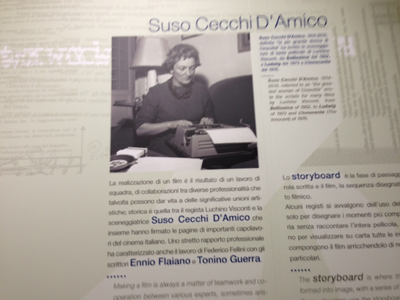As part of my visit to Rome’s International Film Festival, I figured it only makes sense to pay a visit to the birthplace of Italian cinema – Cinecitta’ Studios, It’s about 40 minutes from the center of Rome, going through some suburbs that later my guide informed me are not considered great places to hang out.
 Entrance
Entrance
Cinecitta’ studios were founded in 1937 by Benito Mussolini and his head of cinema Luigi Freddi for propaganda purposes and so most of the grand directors from the 40’s – such as Roberto Rossellni and Vittorio Di Sica – got their backing from the government in order to produce their films. And during the 50’s and 60’s Cinecitta’ have grown in popularity where Fellini made all his films with Italian artistry reaching new heights, thus attracting American productions to be executed there like Ben Hur. That prosperous period was called Hollywood sul Tevere (Hollywood on the Tiber) with big American productions made there.
 Prop from Fellini’s 1976 film Casanova, now situated in the open court at Cineceitta’ Studios.
Prop from Fellini’s 1976 film Casanova, now situated in the open court at Cineceitta’ Studios.
Nowadays, with the deteriorating European economy, Cinecitta’ is not doing that great. There are still TV and movie productions done there – including Martin Scorsese’s 2002 Gangs of New York (original set is still being reused) – but the studio is indeed struggling. My guide told me that Giulio Andreotti (prominent Italian politician) issued a law that some percentage of movies’ proceeds produced in the studio will be extracted to support the studio.
I arrived at 4pm during a rather rainy day to the main gate. The plan is simple: a) visit the exhibit and b) have a tour guide on the set. I highly recommend taking a tour guide seeing the amazing sets and visiting the exhibit.
The Exhibit:
The exhibit has two categories: overview of Italian cinema in general and a special area dedicated to Fellini’s work. The following entails my impressions:
 Open sign that depicts the history of Cinecitta’ Studios (click image to enlarge).
Open sign that depicts the history of Cinecitta’ Studios (click image to enlarge).

The exhibit has a narrow corridor where classic masterpieces are projected from the ceiling down onto the floor and are reflected back from side mirrors. The result is total immersive experience. Smaller rooms are on both sides of corridor, each dedicated to a different cinematic discipline.

Still in the exhibit in a room dedicated to screenplay giants like this one: Suso Cecchi D’Amico. Among her many accomplishments did you know the ending of Bicycle Thieves (turning the father into a bike thief) was her idea?
The Tour Guide:
It could be that it was a rainy afternoon or the fact that this is not #1 tourist attraction in Rome, but the group tour guide to my delight ended up as being an individual show and tell with our guide walking us through the history behind prominent sets in the facility and general observations about current state. Here are a few examples:

After walking around all day and seeing Rome’s timeless monuments, it was astonishing to see how this medieval village set felt so real although fake. All the textures of buildings and pavements that supposedly lasted eons are in fact prints…


Carissimo Shlomi
Grazie so much for reporting from Rome. I believe you gave us the right inspiration to work on a cinema tour in Rome together.
Talk to you soon
Laura